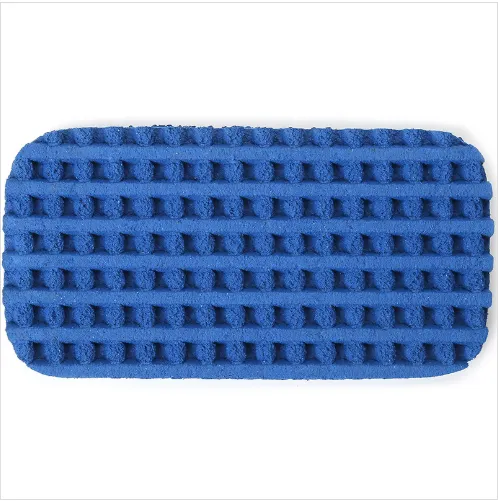mar . 21, 2025 16:45 Reen al listo
The Installation Process and Tips for Running Track Flooring
When it comes to creating a top-notch running track, whether it’s a rubber running track for a professional sports facility, an outdoor running track in a park, or a synthetic running track at a school, the installation process is crucial. ENLIO, a trusted name in the industry, offers high-quality running track flooring solutions that are not only durable but also designed for easy installation. Let’s take a closer look at the installation process and some valuable tips for different types of running tracks, including those relevant to a publika kurejo and the use of rubber outdoor mat for playground areas which can also be incorporated into running track setups.

Pre-installation Preparation of Rubber Running Track
Before starting any installation, a thorough site evaluation is essential. For an outdoor running track, factors such as the terrain, drainage, and sunlight exposure need to be considered. ENLIO’s experts recommend checking the ground for any unevenness or soft spots. If the site is in a public area, like a publika kurejo, ensure that there are no potential hazards nearby, such as exposed tree roots or utility lines. For a rubber running track or a synthetic running track, a flat and stable base is a must. If the base is not level, it can lead to an uneven running surface, increasing the risk of tripping and injury.
ENLIO offers a variety of running track flooring materials. For a rubber running track, our high-quality rubber compounds are known for their excellent shock absorption and durability. The rubber outdoor mat for the playground, which can also be used in parts of a running track, is designed to withstand heavy use and various weather conditions. Synthetic running track materials from ENLIO are engineered to provide a consistent running surface, mimicking the feel of natural tracks while offering enhanced performance. When choosing the material, consider the intended use of the track. A professional sports facility may require a more high-performance synthetic running track, while a publika kurejo might benefit from a more cost-effective yet durable rubber running track.
Installation Steps of Rubber Running Track
The first step in installing running track flooring is preparing the base. For an outdoor running track, the ground needs to be excavated to a proper depth, usually around 10-15 centimeters. Compact the soil firmly to create a stable base. Then, add a layer of gravel or crushed stone for better drainage. For indoor or synthetic running tracks, a concrete or asphalt base may be required. Ensure that the base is smooth and level. ENLIO provides detailed guidelines on base preparation for different types of running tracks to ensure optimal results.
For a rubber running track, our rubber tiles or sheets are easy to install. They often come with an interlocking system, allowing for quick and seamless installation. Start from one end of the track and work your way around, ensuring that each tile or sheet is properly aligned. For a synthetic running track, the installation process may involve spreading a liquid synthetic material over the base and then applying a top layer with the desired texture. In the case of using rubber outdoor mat for playground areas within the running track, these mats can be laid in areas where extra cushioning is needed, such as around curves or near starting and finishing points.
Once the flooring is laid, securing the edges is crucial. Use appropriate adhesives or mechanical fasteners to keep the flooring in place. In an outdoor running track, the edges need to be protected from water seepage. ENLIO offers edge-sealing products that are weather-resistant and long-lasting. For a publika kurejo, ensure that the edges are smooth and free from any sharp protrusions to prevent injuries.
Installation Tips for Rubber Running Track
When installing running track flooring, especially synthetic or rubber materials, temperature and humidity play a significant role. For rubber running track installation, it's best to work in temperatures between 15-25 degrees Celsius. High humidity can affect the adhesion of the flooring materials. In the case of synthetic running track installation, extreme temperatures can cause the material to expand or contract, leading to uneven surfaces. ENLIO’s installation guides provide specific temperature and humidity ranges for different types of flooring materials.
Throughout the installation process, quality control is essential. Regularly check the alignment of the flooring, the smoothness of the surface, and the integrity of the edges. In a publika kurejo, where there will be a high volume of users, any imperfections can lead to safety issues. ENLIO recommends having a quality control team or inspector on-site during the installation to catch and rectify any problems immediately.
The installation of running track flooring requires careful planning and execution. With ENLIO's high-quality running track flooring solutions and our detailed installation guidelines and tips, you can create a safe, durable, and high-performance running track. Whether you are a sports facility manager, a park administrator, or a contractor working on a publika kurejo project, contact ENLIO sports flooring company today to explore our wide range of running track flooring options and ensure a successful installation.
-
Best Table Tennis Flooring: Ultimate Guide for Gyms & Players
NovaĵojAug.01,2025
-
Why Do Professional Basketball Courts Choose Double-Layer Keels? ENLIO Wood Sports Flooring Provides the Answer
NovaĵojJun.06,2025
-
SES Outdoor Sport Court Tiles: How the Multi-Hollow Drainage System Revives Outdoor Courts in 10 Minutes After Rain
NovaĵojJun.06,2025
-
Professional-Grade YQ003 Basketball Stands for Sale: High-Strength Steel and Safety Glass Backboards Redefine Venue Standards
NovaĵojJun.06,2025
-
ENLIO Rubber Playground Mats: Why 80% of Daycares Ban Foam Mats? Hidden Toxicity Risks in Cheap Alternatives
NovaĵojJun.06,2025
-
8.0mm Crystal Sand Surface Badminton Court Mat: How Professional-Grade Anti-Slip Technology Revolutionizes Grip Experience
NovaĵojJun.06,2025

